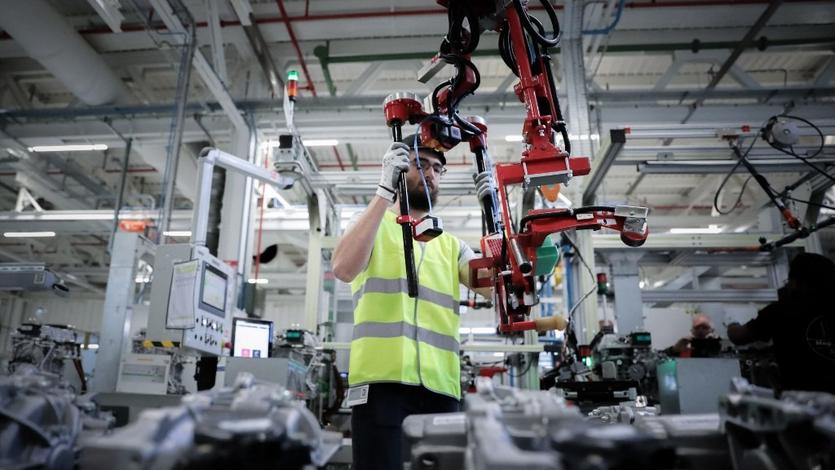 An employee works on electric car equipments at the Renault factory in Cleon, northwestern France on July 5, 2022. (LOU BENOIST / AFP)
An employee works on electric car equipments at the Renault factory in Cleon, northwestern France on July 5, 2022. (LOU BENOIST / AFP)
LONDON/TOKYO - Global factory output weakened in October as widespread recession fears and high inflation hurt demand, business surveys showed on Tuesday, adding to persistent supply disruptions and darkening recovery prospects.
Inflation has soared globally as supply chains still healing from the coronavirus pandemic were hit again by the conflict in Ukraine, forcing consumers to rein in purchases.
British manufacturing suffered its biggest contraction since the depths of the first COVID-19 lockdown in May 2020 last month, suggesting a deepening slowdown was underway
British manufacturing suffered its biggest contraction since the depths of the first COVID-19 lockdown in May 2020 last month, suggesting a deepening slowdown was underway.
The final S&P Global UK Manufacturing Purchasing Managers' Index (PMI) for October fell to 46.2 from 48.4 in September, further below the 50-point mark that separates growth from contraction.
ALSO READ: Global economy: Factories battling with delays, rising costs
"October's PMI data suggest the manufacturing sector is teetering on the edge of a recession," said Gabriella Dickens, senior UK economist at Pantheon Macroeconomics.
"Looking ahead, demand for industrial goods looks set to fall further as real incomes continue to be hit by above-target inflation, the watering down of government support for energy bills in April, austerity measures and higher unemployment."
Manufacturing PMIs due on Wednesday for the euro zone are likely to show an ongoing downturn deepened last month as the cost of living crisis kept consumers wary.
Meanwhile in Switzerland, the PMI reading dipped by 2.2 points but remained in positive territory at 54.9 points, illustrating the ongoing resilience of the local economy.
ALSO READ: Global slowdown fears darken prospects for Asian factories
Still, the challenging international environment, uncertainties over the supply situation and high energy prices are increasingly slowing Swiss factory activity, Credit Suisse analysts said.
Factory activity shrank in South Korea, China’s Taiwan region and Malaysia in October, and expanded at the slowest pace in 21 months in Japan, highlighting the pain from stubbornly high import costs.
"Another big risk is the pace of US rate increases. If the Federal Reserve continues to hike rates steadily, that could ignite capital outflows from Asia and hurt exports," said Toru Nishihama, chief economist at Dai-ichi Life Research Institute in Tokyo.
Further US interest rate hikes are expected to force other central banks to act to prevent sharp capital outflows by tightening their own monetary policies, even if it means cooling already soft economies, analysts say.
ALSO READ: China's recovery key to global growth
Highlighting how the pain from soaring material costs and supply constraints outweighed the boost from a weak yen, auto giant Toyota Motor Corp on Tuesday posted a 25 percent drop in quarterly profit and cut its annual output target
Japan's au Jibun Bank Japan Manufacturing PMI fell to 50.7 in October from September's 50.8 final, marking the weakest growth since January last year.
Highlighting how the pain from soaring material costs and supply constraints outweighed the boost from a weak yen, auto giant Toyota Motor Corp on Tuesday posted a 25 percent drop in quarterly profit and cut its annual output target.
South Korea's factory activity shrank for a fourth straight month in October as orders for exports fell for an eighth month, the PMI showed.
Taiwan region and Malaysia both saw deeper contractions in manufacturing, while in Indonesia activity expanded again in October but at a slower pace than the previous month.
READ MORE: Asia's factories recovering as restrictions ease after Delta hit
India was an outlier with factory activity expanding at a stronger pace in October as demand remained solid.
The International Monetary Fund cut Asia's economic forecasts as global monetary tightening and rising inflation blamed on the conflict in Ukraine dampened the region's recovery prospects.


